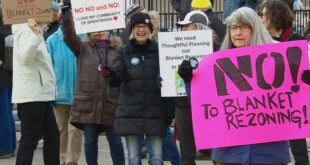There’s a sense of safety in Ontario city’s encampments, but also fear as colder weather approaches.

Aaron Ranta didn’t expect he’d be sleeping outside this summer, but when he recently lost his apartment in Thunder Bay, Ont., he didn’t have another option.
He has been staying in a tent for about three weeks and is actively looking for a new place to live. He has met a lot of other people in similar situations and has spent much of his time helping them, handing out water bottles and keeping the area clean.
“Most people are freaking half a step away from being here themselves,” he said. “I would just like people to treat [us] like we’re normal people. We are normal people. Nobody wants to be here.”
Outreach workers in the northwestern Ontario city are aware of more people sleeping outside than ever before: 140 at the end of July compared to a peak of 55 last year.
Last year, organizations like Elevate NWO helped 100 people get into housing. But this year, there’s been little to no movement in getting people indoors because there just aren’t enough units available.
“I’m really worried about what this winter might bring, given the current numbers that we’re sitting at,” said Cynthia Olsen, the city’s director of strategic initiatives and engagement.
Housing is a human right
Outreach workers have focused their efforts on meeting people where they are at. This strategy was further solidified in April, when council voted in favour of the city taking a human rights-based approach to the encampments.
This is in contrast to efforts elsewhere, such as in the Region of Waterloo, to remove encampments from public spaces. That attempt was shot down by an Ontario Superior Court ruling, which said the municipality could not remove encampments if it could not provide enough shelter beds to meet demands.
“Any time you disperse somebody from a location, you run the risk of actually losing them to the system or losing them to follow up, and then have to start that process all over again,” Olsen said.
“Hearing more about a human rights-based approach was just recognizing that people have the right to housing. It is a fundamental right under the Canadian Charter of Human Rights.”

The District of Thunder Bay Social Services Administration Board (TBDSSAB) is the community service provider charged with managing social housing.
As of the end of June:
- 1,217 people were on the waitlist for community housing.
- 56 people were on the high-needs homeless waitlist, which means they are given priority for housing.
From January to the end of June, TBDSSAB moved 21 people off the high-needs homeless waitlist. In that same period, outreach workers have directly helped 39 people get into housing, though there may be an overlap of the same people represented in both figures, said Ken Ranta, TBDSSAB’s director of integrated social services.
“It’s certainly not as simple as saying, ‘Let’s build a large apartment building and give everybody a place to stay,’ because many of them need a level of support to allow them to be successful in that home environment, and that’s where I would suggest a whole-of-community approach,” he said.
Sense of safety, community at encampments
What’s new about the homelessness the city is facing isn’t that people are sleeping outside, but that they’re staying in more open spaces, said Ken Ranta.
“It’s much more visible now and some of that goes to … the sense of safety, community, security, the opportunity for a number of individuals to feel part of a community.”
Being more visible also means it is easier for people to access support. Many people who aren’t homeless come to visit the encampments to access resources from outreach workers because they know it is a safe space for them, he explained.
However, Aaron Ranta said that sometimes, people who don’t live in the encampments come there and cause trouble, creating tensions. There is also the problem of the stigma surrounding homelessness, which follows them wherever they are staying.
A smile goes a long way and most people just want someone to talk to. – Aaron Ranta, a person experiencing homelessness in Thunder Bay, Ont.
“There’s shame based around most things. If I go to ask for help, you feel ashamed,” he said. “I see [people] all the time panhandling … you can see that look on their face, it’s just defeat.
“A smile goes a long way and most people just want someone to talk to,” Aaron said.
Michelle Wojciechowski, TBDSSAB’s manager of intake and eligibility, oversees the transitional outreach workers team that works with the city’s homeless population.
She said a big part of their success has been building relationships with people and meeting them wherever they feel comfortable.
“Knowing that they are looking out for their best interest and they’re going to support them, and how much more successful that is once they’ve had that relationship building complete — continuing that level of support is instrumental.”
City resources strained
Mayor Ken Boshcoff has visited several encampments this summer. He’s noticed many people are experiencing health issues, but there’s a sense of community among people living there.
Thunder Bay has always been a service hub for a lot more than its permanent residents, he said. While Statistics Canada reports the city’s population is about 120,000, some provincial ministers consider the served population to be between 140,000 and 150,000.
“We know our service agencies, from the hospital to the addictions area, are really stretched,” Boshcoff said.
This makes it difficult to address homelessness in a substantial way, which is why the city is pushing for more resources from upper levels of government to ease the burden on service providers locally, the mayor said.
“I do believe that we really have hit a wall capacity-wise, so that reflects that we need federal help on the Indigenous side, and we need more health capacity and addictions support from the provincial side.
“We really have reached what I would call a near breaking point.”
‘Everybody has a story’
With winter coming, that wall is closing in fast. Outreach workers from different agencies meet regularly to talk about the situation as it evolves and make sure there aren’t any gaps in services. But Ken Ranta, from the TBDSSAB, said the entire community needs to participate.
“The only way to really fully address the needs of the homeless population is to have an all-of-community approach. There needs to be not only willingness to participate by all types of service providers, but almost a mandate,” he said. “You almost have to require participation from every sector if we’re going to make it a real meaningful solution to a homelessness crisis.”
Aaron Ranta just wants Thunder Bay to remember that those sleeping in tents are going through hard times.
“Don’t judge them, don’t look down your nose at them. Just realize that they’re still people, too,” he said. “Everybody has a story … so it doesn’t matter who you are, don’t think you’re any better or any worse than anybody.”
ABOUT THE AUTHOR
Sarah Law is a CBC News reporter based in Thunder Bay, Ont., and has also worked for newspapers and online publications elsewhere in the province. Have a story tip? You can reach her at sarah.law@cbc.ca
*****
Credit belongs to : www.cbc.ca
 Atin Ito First Filipino Community Newspaper in Ontario
Atin Ito First Filipino Community Newspaper in Ontario






